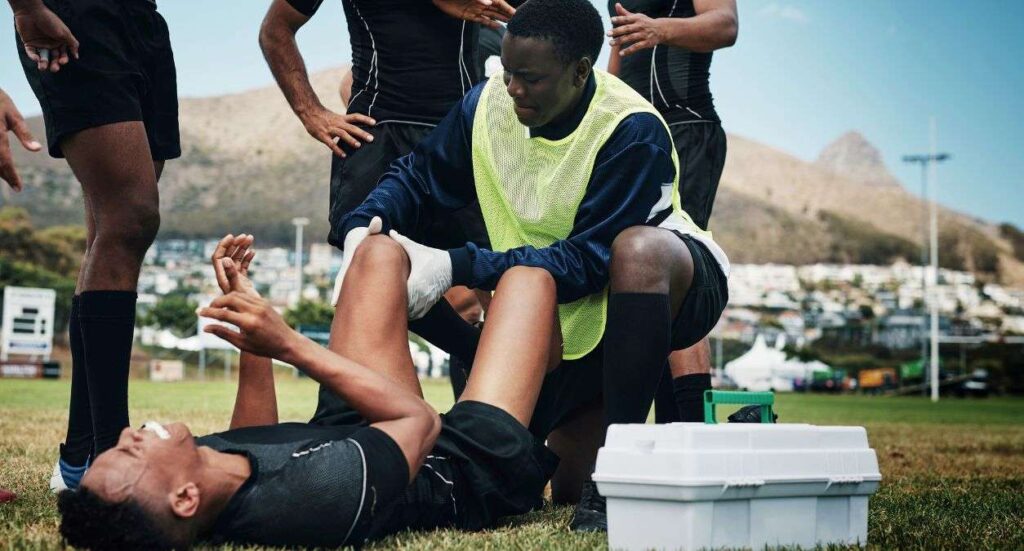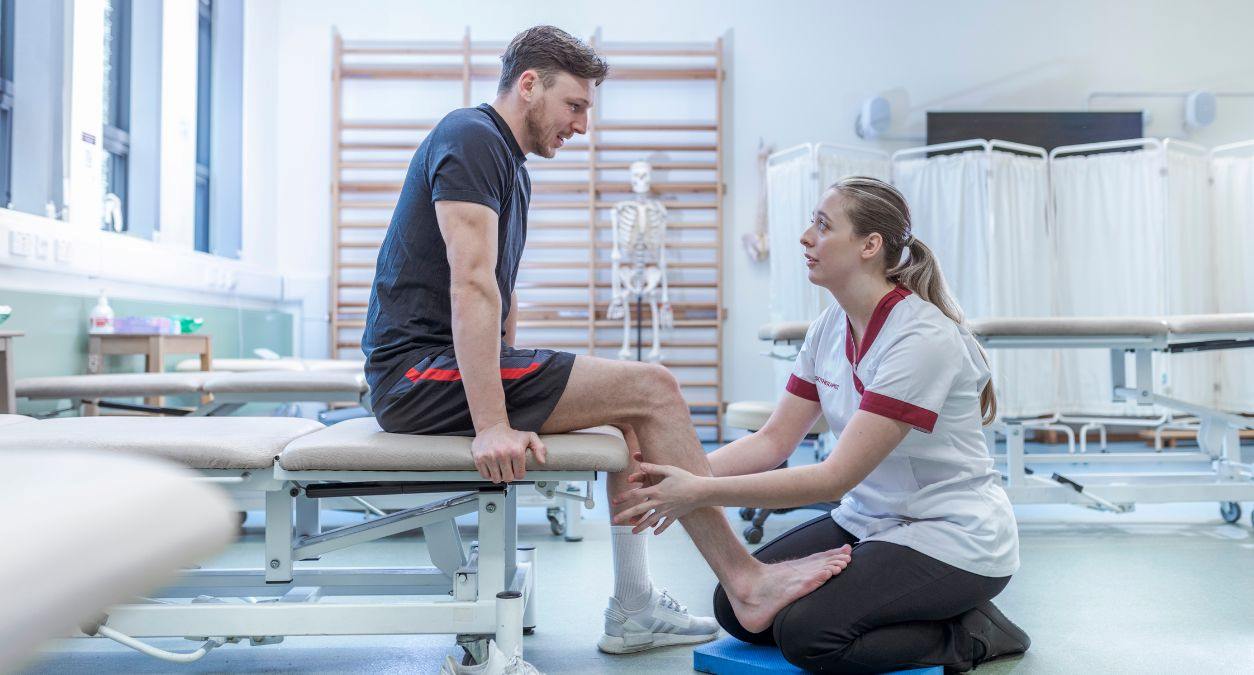Table of contents
Table of contents
In today’s health-conscious society, careers in sports therapy and massage are more relevant than ever. Whether you’re passionate about injury prevention, rehabilitation, or enhancing athletic performance, a role in massage and sports therapy could offer both fulfilment and opportunity. From pitch-side emergency care to clinical treatments, sports therapy opens up a wide array of career paths.
This blog will explore the different jobs available to sports massage therapists, explain the difference between a sports therapist and a sports massage therapist, and cover essential details such as sports therapy pay and daily responsibilities. Whether you’re just starting out or considering a career shift, here’s everything you need to know.
What is sports therapy and massage therapy?
Sports therapy and massage therapy involve the prevention and treatment of injuries related to physical activity. These practices help athletes – and active individuals – recover faster, move better, and perform at their best.
While massage sports therapy focuses more on the manipulation of soft tissues to reduce pain, tension, and improve mobility, sports therapy encompasses a broader scope. It includes injury assessment, rehabilitation, exercise prescription, and in some cases, emergency care.
Many professionals combine both skills, creating a hybrid approach to treatment and care, which makes them incredibly valuable in both clinical and sporting environments.
What does a sports therapist do?

A sports therapist works with people at all levels of physical activity, from elite athletes to casual gym-goers. Their job responsibilities may include:
- Injury assessment and diagnosis
- Creating and delivering rehabilitation programs
- Manual therapy techniques including massage
- Prevention strategies to reduce the risk of injury
- Providing pitch-side first aid or emergency care
- Working closely with coaches and other healthcare professionals
Sports therapists often operate in private clinics, sports clubs, gyms, or even freelance. Their work is hands-on, highly varied, and often physically demanding, but incredibly rewarding.
Career paths in sports therapy and massage therapy

Once qualified, a wide range of career options open up for professionals in massage and sports therapy. Here are some of the most common and emerging career paths:
Private practice or freelance work
Many sports massage therapists choose to set up their own businesses. Freelancing offers flexibility and control over your client base and working hours. You could specialise in a certain sport or offer general sports massage and therapy services to the local community.
To work independently, you’ll need insurance. Our Sports Therapist Insurance policy offers tailored cover for those providing physical treatments, ensuring you’re protected from liability claims.
Working with sports teams
Professional or semi-professional sports teams often hire sports therapists to work full-time or part-time. These roles involve:
- Match-day preparation and recovery
- Injury management
- On-site rehabilitation
- Emergency first aid
This is a fast-paced environment where your expertise can make an immediate impact on performance and recovery.
Health and wellness clinics
A growing number of health and wellness centres now incorporate sport therapy as part of their treatment offerings. You could work alongside physiotherapists, osteopaths, and chiropractors, offering integrated care.
Corporate wellness programs
Injuries aren’t exclusive to athletes. Many companies invest in workplace wellness, offering massage therapy to staff. This career route can be especially appealing due to regular hours and a broad client base.
Academic or teaching roles
With experience and further qualifications, you might move into teaching, training or lecturing in sports therapy or massage therapy. This path allows you to pass on your knowledge to the next generation of professionals.
Sports therapy pay: what can you earn?

So, how much does a sports therapist earn? Like many careers, salaries can vary widely depending on your experience, location, and the setting you work in.
Here’s a general guide:
- Entry-level sports therapists typically earn between £18,000 and £22,000 per year.
- Experienced professionals can expect to earn £25,000 to £35,000, especially if working with high-level athletes or private clients.
- Freelancers or clinic owners may earn significantly more, but income can vary depending on clientele and hours worked.
- Sports massage therapists often charge between £30 to £60 per session in the UK.
To find out more about career steps and income, visit our in-depth guide on how to become a sports therapist.
Qualifications and skills required
To pursue a career in sports and massage therapy, you’ll need the right qualifications:
Sports therapist
- A BSc (Hons) in Sports Therapy or equivalent
- Registration with a recognised professional body like SST (The Society of Sports Therapists)
- First aid training, especially if working pitch-side
Sports massage therapist
- Level 3 or Level 4 Diploma in Sports Massage Therapy
- Insurance to practice professionally
- Strong understanding of anatomy and physiology
Soft skills like communication, empathy, attention to detail, and physical stamina are just as important as formal qualifications.
Difference between a sports therapist and sports massage therapist
Many people confuse the roles, but there are important differences between sports therapists and sports massage therapists:
|
Both roles are vital, and some professionals choose to qualify in both areas to offer a more comprehensive service.
Job outlook and industry trends
The UK sports therapy and wellness industry is expanding, thanks to rising awareness of health and performance. With more people seeking non-invasive treatments, careers in massage sports therapy are expected to grow steadily.
There’s also increasing demand for specialist knowledge in areas like:
- Women’s sports rehabilitation
- Post-surgical recovery
- Geriatric and adaptive sports therapy
- Long COVID rehabilitation
By diversifying your skill set, you can find a niche that keeps you in demand.
How to get started
If you’re interested in a career in sports therapy or massage, here are the first steps:
Choose your path
Decide whether you want to pursue massage therapy, full sports therapy, or both.
Get qualified
Enrol in a reputable course with accreditation.
Gain experience
Volunteer with sports clubs, shadow professionals, or take internships.
Get insured
Protect your business and clients with comprehensive sports therapist insurance.
Market yourself
Build a website, join directories, and network with local gyms and clinics.
Conclusion
A career in sports therapy and massage can be dynamic, rewarding, and financially stable. Whether you’re working with athletes, office workers, or anyone in between, your skills can transform lives through better movement, recovery, and wellbeing.
If you’re ready to take the leap, ensure you’re equipped with the right qualifications, experience, and professional cover. Don’t forget to check out our guide on how to become a sports therapist to get started.
Get Sports Therapist Insurance from Protectivity
*Disclaimer – This blog has been created as general information and should not be taken as advice. Make sure you have the correct level of insurance for your requirements and always review policy documentation. Information is factually accurate at the time of publishing but may have become out of date.
Last updated by

















